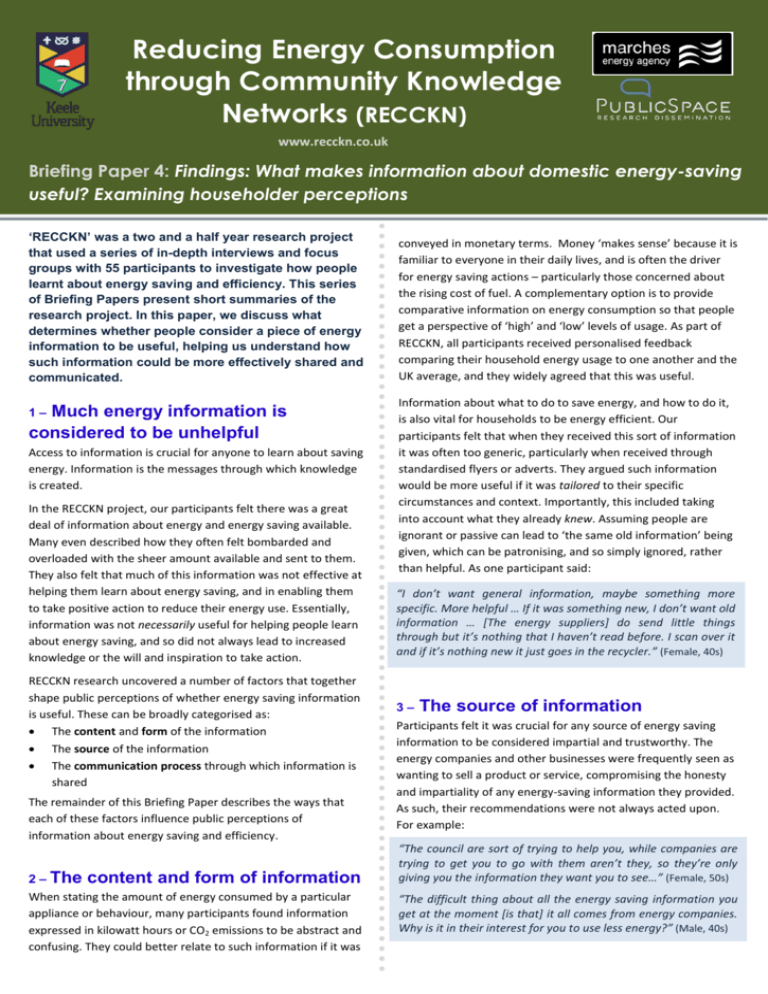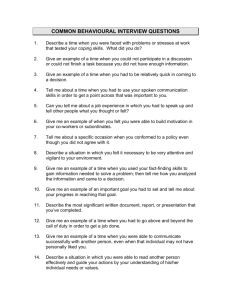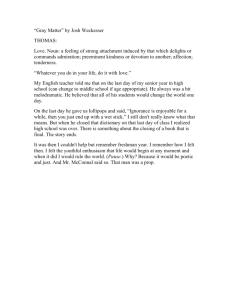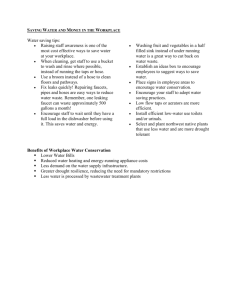Briefing Paper 4 - What makes energy information useful
advertisement

Reducing Energy Consumption through Community Knowledge Networks (RECCKN) www.recckn.co.uk Briefing Paper 4: Findings: What makes information about domestic energy-saving useful? Examining householder perceptions ‘RECCKN’ was a two and a half year research project that used a series of in-depth interviews and focus groups with 55 participants to investigate how people learnt about energy saving and efficiency. This series of Briefing Papers present short summaries of the research project. In this paper, we discuss what determines whether people consider a piece of energy information to be useful, helping us understand how such information could be more effectively shared and communicated. Much energy information is considered to be unhelpful 1– Access to information is crucial for anyone to learn about saving energy. Information is the messages through which knowledge is created. In the RECCKN project, our participants felt there was a great deal of information about energy and energy saving available. Many even described how they often felt bombarded and overloaded with the sheer amount available and sent to them. They also felt that much of this information was not effective at helping them learn about energy saving, and in enabling them to take positive action to reduce their energy use. Essentially, information was not necessarily useful for helping people learn about energy saving, and so did not always lead to increased knowledge or the will and inspiration to take action. RECCKN research uncovered a number of factors that together shape public perceptions of whether energy saving information is useful. These can be broadly categorised as: The content and form of the information The source of the information The communication process through which information is shared The remainder of this Briefing Paper describes the ways that each of these factors influence public perceptions of information about energy saving and efficiency. 2 – The content and form of information When stating the amount of energy consumed by a particular appliance or behaviour, many participants found information expressed in kilowatt hours or CO2 emissions to be abstract and confusing. They could better relate to such information if it was conveyed in monetary terms. Money ‘makes sense’ because it is familiar to everyone in their daily lives, and is often the driver for energy saving actions – particularly those concerned about the rising cost of fuel. A complementary option is to provide comparative information on energy consumption so that people get a perspective of ‘high’ and ‘low’ levels of usage. As part of RECCKN, all participants received personalised feedback comparing their household energy usage to one another and the UK average, and they widely agreed that this was useful. Information about what to do to save energy, and how to do it, is also vital for households to be energy efficient. Our participants felt that when they received this sort of information it was often too generic, particularly when received through standardised flyers or adverts. They argued such information would be more useful if it was tailored to their specific circumstances and context. Importantly, this included taking into account what they already knew. Assuming people are ignorant or passive can lead to ‘the same old information’ being given, which can be patronising, and so simply ignored, rather than helpful. As one participant said: “I don’t want general information, maybe something more specific. More helpful … If it was something new, I don’t want old information … [The energy suppliers] do send little things through but it’s nothing that I haven’t read before. I scan over it and if it’s nothing new it just goes in the recycler.” (Female, 40s) 3– The source of information Participants felt it was crucial for any source of energy saving information to be considered impartial and trustworthy. The energy companies and other businesses were frequently seen as wanting to sell a product or service, compromising the honesty and impartiality of any energy-saving information they provided. As such, their recommendations were not always acted upon. For example: “The council are sort of trying to help you, while companies are trying to get you to go with them aren’t they, so they’re only giving you the information they want you to see…” (Female, 50s) “The difficult thing about all the energy saving information you get at the moment [is that] it all comes from energy companies. Why is it in their interest for you to use less energy?” (Male, 40s) Other, ‘impartial’ sources of information, with no perceived sales agenda, are required for people to feel confident in the accuracy of advice. As one participant commented: The following quotes provide examples of participants negatively describing ‘one-way’ communication processes: “When you feel as if people are pushing it down on you, you go the opposite way.” (Female, 50s) “…you want to go to someone where you think you’ll get impartial advice, not where somebody’s got some sort of axe to grind.” (Female, 50s) “You don’t want to [have] a conference or something like that [to share energy information] because people aren’t going to come along … they will think, oh conference, that means I have got to sit down and listen to a load of people talk.” (Male, 40s) Participants also felt it was important for an information source to be in some way ‘knowledgeable’. As long as they were trustworthy, trained professionals or ‘experts’ were considered very useful by many participants, who felt they could provide detailed and accurate advice on technical issues. However, some participants commented that they didn’t know where to find a professional expert that was also impartial and trustworthy. Instead, our participants often advocated an ‘interactive’ form of communication, in which the communication is a two-way dialogue, and information is exchanged rather than ‘transmitted’. In this situation, they had a chance to ask the questions they wanted answered, and to explain their circumstances and current level of knowledge. Interactive processes could therefore help ensure the advice provided was relevant, that people felt a sense of control, and could build trust in information and its source. Many participants described how hearing from other ‘normal householders’, especially if they had personal experience of a topic, was also very valuable. They could provide practical, useable advice and recommendations of ways to save energy and money, and help people feel confident and motivated enough to take action themselves. For example: Sometimes, participants suggested the internet and online discussion forums as examples of interactive processes. More often, they advocated face-to-face discussion: “I can’t waste time just going listening to burbling on. I think it’s good if people submit questions and then they were answered. That could be done by email, but I think sometimes getting together and sharing ideas would be quite good.” (Female, 60s) “…I suppose word of mouth is best isn't it … because people have, you know, they have genuine experience.” (Male, 30s) “Q: Which do you find to be the most helpful information sources? I think talking to people, really. I do really actually think talking to people who might say, oh, my god, I've got a really good deal, or this is happening.” (Female, 60s) “I was wondering about the possibilities say of a public meeting … I like to hear people face-to-face and hear them respond to arguments, because then I think you are getting a fairer view, than if you're just being pressured from one side.” (Female, 80s) “…if it looked like a brilliant offer I’d be quite suspicious until I’d looked to see what other people are doing.” (Female, 50s) In summary, the advice of trustworthy ‘experts’ and peers with personal experience each provide a certain type of know-how – technical detail from experts, and practical, grounded advice from peers. It seems both are valuable for giving people the knowledge they need to efficiently use energy. 4– 5– Summary A number of factors influence whether people consider information to be useful and worth acting upon. These relate not only to the content of information, but also its source and the way it is communicated. Therefore, assessments of information’s usefulness are shaped by social factors as much as psychological ones. In terms of content, information needs to be relevant and tailored as much as possible to people’s situations. Sources of information need to be trustworthy, and knowledgeable in some way. Peers with personal experience can be as useful as professional experts. Information shared through dialogue is often perceived more positively than that communicated through oneway lectures that attempt to impose knowledge These factors are not discrete. Holistic strategies, shaped around all of the factors outlined here, are required for information to be more effectively shared. The communication process Participants suggested they disliked information communicated through a ‘one-way’ process, in which an information source unilaterally decides what advice is given, and when and where it is provided, with little chance for the recipient to ask questions or explain their situation. Participants described three main problems with this type of process: It made them feel that they lacked control and were being imposed upon. By trying to ‘transfer’ knowledge without understanding the recipient’s context, the information provided could be irrelevant and the process patronising. It created distrust by giving the impression the provider was merely imposing their own agenda. If you have any questions or comments about the RECCKN project contact Professor Andrew Dobson at: a.n.h.dobson@keele.ac.uk. For more info, see the project website www.recckn.co.uk





